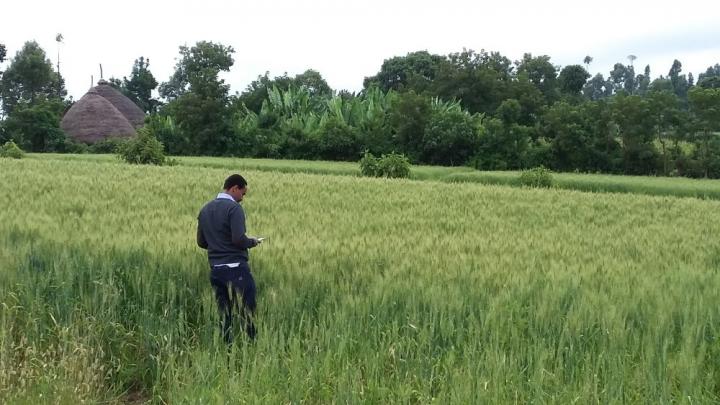Findings may reflect influence of genetically resistant varieties; could help reduce risk of crop failure and famine

Credit: Dave Hodson (CC BY 4.0 https://creativecommons.org/licenses/by/4.0/)
A new study of wheat rust–a fungal disease that can harm wheat crops–identifies previously unknown long-term trends and hotspots for wheat rust outbreaks in Ethiopia. A team of modelers from the University of Cambridge and the Universität Hamburg, along with surveillance experts from CIMMYT, EIAR and agricultural universities in Ethiopia, present these findings in the open-access journal PLOS ONE on February 3.
Ethiopia is a major wheat producer, and millions of its households rely on the crop as a source of income or sustenance. Wheat rust poses a significant threat to wheat production; outbreaks can lead to crop failure and boost risk of famine. Today, crop surveillance data fuels an early warning system for wheat rust outbreaks in the country, but a comprehensive understanding of past outbreaks has been lacking.
To fill this gap, Meyer and colleagues evaluated 13 years’ worth of surveillance data from more than 13,000 fields across Ethiopia. They employed geographical analysis, statistical tools, and data-driven modeling to identify long-term, countrywide trends for the three types of wheat rust: stem, stripe, and leaf.
The analysis showed that all three types of wheat rust have contributed to recurrent outbreaks over the past decade, causing estimated economic losses of tens of millions of U.S. dollars per year. Each type poses increased risk in distinct geographical hotspots, and the two most common types (stem and stripe) display distinct directional trends in their prevalence. All three types vary in prevalence according to altitude.
The researchers also found evidence for a “boom-and-bust” outbreak cycle that may result from widespread adaptation of specific wheat varieties bred for genetic resistance to certain subtypes of wheat rust, only for resistance to break down or other subtypes to infect the crops.
These findings could help improve wheat rust surveillance and control efforts, such as targeted application of fungicides and planting of certain rust-resistant wheat varieties in key geographical locations. The results could also aid development of mathematical models to accurately predict future outbreak patterns.
The authors add: “Comprehensive annual field surveillance efforts combined with methods from data-science reveal patterns in large-scale epidemics of potentially devastating fungal diseases of staple crops of wheat in Ethiopia, the principal country for wheat production in sub-Saharan Africa. The pattern revealed in the analyses for three wheat rust diseases underline the importance of sustained pest management for food security.”
###
Citation: Meyer M, Bacha N, Tesfaye T, Alemayehu Y, Abera E, Hundie B, et al. (2021) Wheat rust epidemics damage Ethiopian wheat production: A decade of field disease surveillance reveals national-scale trends in past outbreaks. PLoS ONE 16(2): e0245697. https:/
Funding: Field surveillance efforts were funded by the Durable Rust Resistance in Wheat (DRRW) and Delivering Genetic Gains in Wheat (DGGW) projects managed by Cornell University and funded by the Bill & Melinda Gates Foundation and the UK Foreign, Commonwealth and Development Office (FCDO). Additional support was provided to the Cambridge University from the Bill and Melinda Gates Foundation, the UK Biotechnology and Biological Sciences Council and FCDO for initiating the data review, cleaning and analysis. The final stages of this study were completed after MM started at the University of Hamburg, funded by the Deutsche Forschungsgemeinschaft (DFG, Germany Research Foundation) under Germany’s Excellence Strategy – EXC 2037 ‘CLICCS – Climate, Climatic Change, and Society’ – Project Number: 390683824, contribution to the Center for Earth System Research and Sustainability (CEN).
Competing Interests: The authors have declared that no competing interests exist.
In your coverage please use this URL to provide access to the freely available article in PLOS ONE: https:/
Media Contact
Dr Dave Hodson
[email protected]
Related Journal Article
http://dx.




